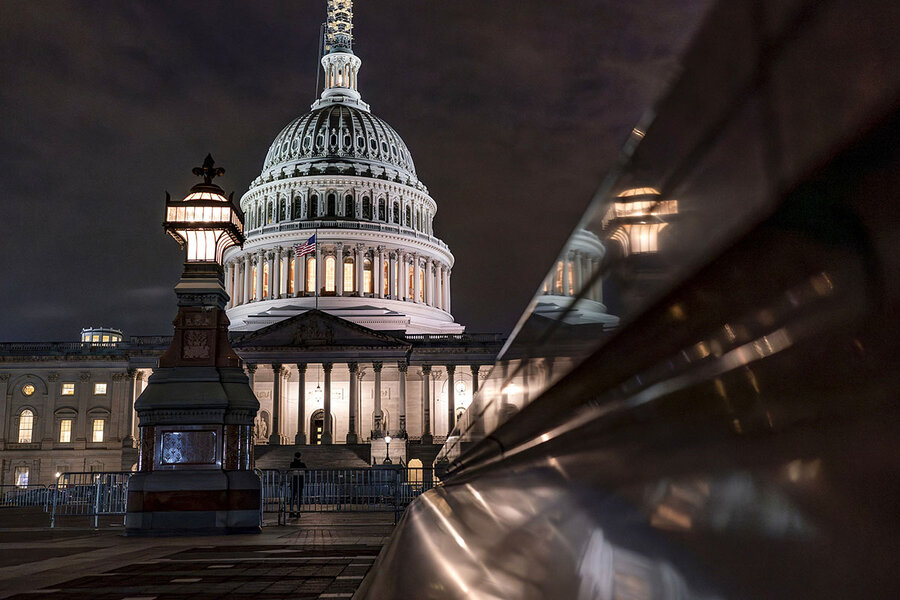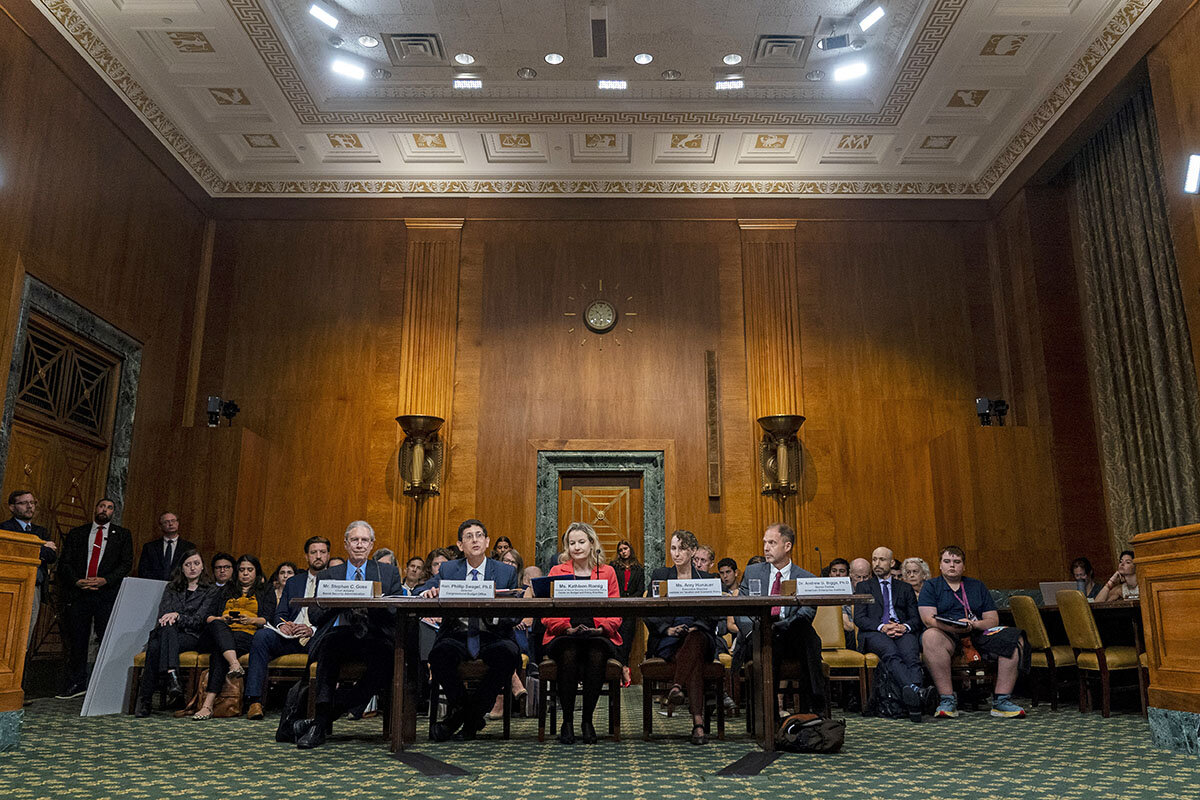Behind impasse in Congress: Rising deficits, record debt
Loading...
Congress bought itself more time with a weekend agreement to avoid a government shutdown, but now a 45-day clock is ticking to reach a deal on the federal budget – and both parties will need to be involved in reaching it.
Partisanship is so intense that expectations in Washington are low that Congress will solve much of anything before elections 13 months from now. The talks in coming weeks will focus on just discretionary spending, not entitlement programs, for one thing.
But the reality is that control of power is narrowly divided between both parties, and doing nothing is not an option. They’ll need to find a deal to keep the government running in 2024. And time, math, and a record $33 trillion national debt dictate that, at some point, leaders in Washington will have to step up to the plate and make other difficult decisions.
Why We Wrote This
A story focused onThere’s an element of political theater to the budget showdown that almost caused a government shutdown in the United States over the weekend. But behind the unfinished drama are difficult challenges of debt and deficits.
The problem, economists say, isn’t that deficits and debt are inherently bad things. Rather, it’s a question of sustainable financing and maintaining public confidence – and the latest trend lines in the United States aren’t good: As a share of the economy, the deficit in the just-finished fiscal year was larger than at any past time when the country did not face a recession or other major emergency like a war. National debt keeps rising even as the interest rates on that borrowing have also surged.
“Like it or not, people will have to stand up – and both sides, the tax side and the spending side, are going to have to give,” says Glenn Hubbard, economics professor at Columbia Business School and a former chair of the president’s Council of Economic Advisers. “I can’t imagine a politically viable solution that says it’s all about taxes or all about spending.”
Rising pressure over taxes, entitlements
Congress doesn’t have to reach a dramatic package of solutions all at once. Deadlines are coming, however.
Its most immediate deadline – Nov. 17 – is the most fungible. That’s when Congress is supposed to pass a dozen spending bills to keep government funded for the year. But legislators have kicked the can down the road before, as they did on Saturday, passing temporary resolutions to keep government funded at current levels. They can do so again.
“We’ve gotten into a cycle where we are budgeting by crisis,” says Shai Akabas, executive director of the economic policy program for the Bipartisan Policy Center, a Washington think tank. “And that doesn’t allow any oxygen for the bigger-picture budget issues that are really quite important.”
Other deadlines are far less forgiving. At the end of 2025, for example, the tax cuts passed early in the Trump administration expire. Congress will be forced to hash out a new tax package or most Americans will see their tax rates go up by 1 to 4 percentage points.
Another deadline is 2033. That’s when the Social Security trust fund reserves are expected to run out. If that happens, the nation’s older citizens – a potent voting bloc – will see their monthly Social Security payments cut by about a quarter. Retirees will still receive benefits because the system will fund those benefits from current contributions of working Americans. But as the population ages and the ratio of retirees to workers increases, the benefits will continue to dwindle.
Medicare is in an even worse situation. Medicare Part A, which covers hospitalization, is expected to see its trust fund exhausted by 2031.
Too big for one party to solve
So far, Congress has avoided making the changes needed to boost funding for these programs or to address federal deficits, which continue to balloon.
“These are very difficult votes,” says Howard Gleckman, a senior fellow at the Tax Policy Center, a Washington think tank. “You’re going to get people mad at you if you cut their spending programs or if you raise their taxes. And the only way to insulate yourself from some of that is to make it bipartisan – for everybody to kind of agree together that they’re going to make these cuts.”
Looming over all of this is the federal debt. For decades, economists have been warning about its dangers. But nothing terrible has happened. The money spent on paying the interest on the debt has not appreciably crowded out funding for private business. Foreign confidence in the dollar has not eroded, although credit ratings are at risk. Like a ship of state drifting into ever deeper waters of red ink, the U.S. has not yet hit an iceberg.
In the meantime, the debt has continued to rise because of spiraling budget deficits. President Donald Trump pushed deficit spending to record highs, first with tax cuts, which reduced federal revenues, and then much more during the pandemic with two stimulus packages designed to keep the economy afloat. President Joe Biden followed with more pandemic relief plus big spending on Democratic priorities including infrastructure and green energy.
Servicing the debt gets costlier
In the past year, the nation’s slide into deep red ink has accelerated. To counter rising inflation – caused at least in part by the record federal spending, economists say – the Federal Reserve has had to dramatically increase interest rates. Those high interest rates, in turn, have made the federal debt more expensive to service. The Congressional Budget Office now estimates the U.S. will spend $10.5 trillion on interest over the next 10 years. “That’s completely nonproductive money,” says Mr. Gleckman of the Tax Policy Center. “I could think of a lot of things the government could do with $10 trillion.”
Congress’ inaction over the years in the face of such rising costs has created extreme frustration on the far right, enough so that the House Freedom Caucus has tried to force budget showdowns this year. First it threatened to hold up a debt limit increase earlier this year, which could have severely damaged the economy by defaulting on Treasury debt. Now come the talks on federal budget appropriations, which could shut down the government if a deal isn’t reached by the new deadline of Nov. 17.
Calls rising for a bipartisan commission
While condemning the conservatives’ intransigence and tactics, many conservative economists are also sounding the alarm over Congress’ inability to deal meaningfully with deficits and the debt. “Enough’s enough,” says Gordon Gray, vice president for economic policy at the American Action Forum. Under President Biden, “we got the American Rescue Plan and we’ve since gotten more and more and more” spending.
Amid the current chaos and conflict in Congress, some budget experts point to signs of progress, especially potential moves to create a federal budget commission that would address in a bipartisan way the twin problems of deficits and debt. Senators on both sides of the aisle have expressed an interest in creating one, and House Speaker Kevin McCarthy included the idea in an earlier resolution to keep the government funded. (The House resolution that eventually succeeded did not include it.)
“That’s an encouraging sign,” says Marc Goldwein, senior policy director at the Committee for a Responsible Federal Budget, a nonpartisan deficit-reduction group in Washington. “Is it enough to save Social Security and stop our debt from rising? No. ... But I think it’s a big first step.”








